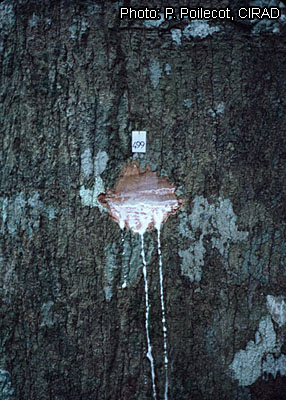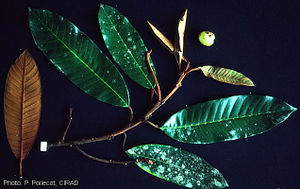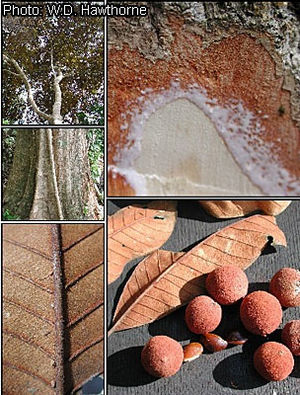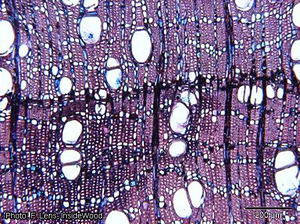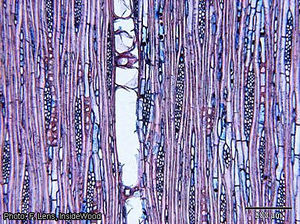Chrysophyllum perpulchrum (PROTA)
Introduction |
Chrysophyllum perpulchrum Mildbr.
- Protologue: Fl. W. trop. Afr. 2: 10 (1931).
- Family: Sapotaceae
- Chromosome number: 2n = 28
Synonyms
- Gambeya perpulchra (Mildbr. ex Hutch. & Dalziel) Aubrév. & Pellegr. (1960).
Vernacular names
- Red asanfena, monkey star apple, bird-lime tree (En).
- Aninguéri rouge (Fr).
Origin and geographic distribution
Chrysophyllum perpulchrum is widely distributed from Guinea east to Uganda and Tanzania.
Uses
The wood (trade name: mululu) is suitable for construction, flooring, furniture, cabinet work, joinery, toys and novelties, musical instruments, turnery, boxes and crates, vats, carvings, veneer and plywood. In Tanzania the wood is also used for grain mortars and beehives.
In Côte d’Ivoire a bark decoction is taken as a tonic, anodyne, galactagogue and aphrodisiac, and to treat jaundice, asthma and other respiratory complaints, and madness. The fruit is sometimes eaten. The latex is used as a rubber substitute and as birdlime.
Production and international trade
The timber of Chrysophyllum perpulchrum is traded internationally in small amounts, but data are not available due to mixing with other Sapotaceae species.
Properties
The heartwood is yellowish or pinkish white to brownish yellow and indistinctly demarcated from the sapwood. The grain is usually straight, texture fine and even. The wood is lustrous. In Sierra Leone the wood is considered too gummy to be useful.
The wood is fairly heavy, with a density of 660–820 kg/m³ at 12% moisture content. The rates of shrinkage from green to oven dry are high: 5.9–6.3% radial and 9.7–10.7% tangential; shrinkage from green to 12% moisture content is 2.0–3.0% radial and 7.2–8.5% tangential. In spite of the high shrinkage, drying is rapid, with little splitting or checking. After drying the wood is not stable.
At 12% moisture content, the modulus of rupture is 143–189 N/mm², modulus of elasticity 14,120 N/mm², compression parallel to grain 69–72 N/mm², cleavage 15.5 N/mm and Chalais-Meudon hardness 5.9. The wood is moderately shock-resistant.
The wood is fairly easy to saw, works well with hand and machine tools, and can be planed to a smooth finish. Pre-boring is necessary before nailing, and the wood holds nails and screws well. The gluing and steam bending properties are good, as are the slicing properties.
The wood is not durable and is liable to attacks by insects. The sapwood is susceptible to Lyctus borers. The sapwood is fairly permeable to preservatives, the heartwood moderately resistant.
The kernel of the seed contains 4% oil, with oleic acid 39%, linoleic acid 31%, palmitic acid 20%, stearic acid 9%, linolenic acid 1% and traces of lauric, myristic and arachidic acid. The alkaloid cardiochrysine has been recorded for the bark; this compound showed depressant activity in the thalamus and hypothalamus, and hypotensive and cardiotonic activity.
Description
- Large tree up to 40 m tall; bole up to 100 cm in diameter, straight and cylindrical, slightly fluted to buttressed at base; bark surface greyish brown, smooth with longitudinal fissures, inner bark fibrous, pale brown, exuding a white sticky latex; young branches densely reddish brown hairy.
- Leaves arranged spirally, simple and entire; stipules absent; petiole 1–3.5 cm long, grooved above; blade elliptical to obovate-oblong, 8–25(–40) cm × 3–9(–14) cm, slightly cuneate to rounded at base, acute at apex, leathery, densely reddish brown velvety hairy beneath, pinnately veined with (11–)14–21(–25) pairs of lateral veins.
- Flowers in axillary fascicles, bisexual or occasionally functionally unisexual, regular, 5-merous; pedicel up to 1.5 mm long; sepals free, broadly ovate, c. 4 mm long, pubescent outside; corolla with c. 2.5 mm long tube and rounded lobes c. 1.5 mm long, hairy at margins, creamy white; stamens inserted near base of corolla tube, opposite corolla lobes; ovary superior, conical to globose, long-hairy, 5-celled, style up to 1.5 mm long.
- Fruit a globose berry 2–4 cm long, densely reddish brown hairy, up to 5-seeded.
- Seeds ellipsoid, flattened, up to 2 cm × 1.5 cm, shiny brown.
- Seedling with epigeal germination; hypocotyl 6–7 cm long, epicotyl c. 2 mm long; cotyledons broadly ovate, 2–5 cm long, leafy.
Other botanical information
Chrysophyllum comprises about 70 species and occurs throughout the tropics. Tropical America is richest in species (about 45), followed by continental Africa (about 15), Madagascar (about 10) and tropical Asia and Australia (together 2). The genus has been subdivided into 6 sections, 2 of which (sect. Aneuchrysophyllum and sect. Donella) contain African species. Chrysophyllum perpulchrum belongs to sect. Aneuchrysophyllum.
Chrysophyllum perpulchrum trees produce fruits in abundance when the bole is 60 cm in diameter, but individual trees with bole diameters of 20 cm may already start fruiting. In Sierra Leone flowering is at the beginning of the dry season, and mature fruits can be found in February–March. In Ghana flowering is in March–April and fruits are ripe in September–December.
Ecology
In West Africa Chrysophyllum perpulchrum occurs in semi-deciduous forest, most abundantly in dry forest types, particularly on slopes. Locally it can be dominant. In East Africa it is found in rainforest at 800–1200 m altitude. Seedlings need shade for proper development. Regeneration is not abundant in dry forest which is regularly burned, and seedlings are more common in less disturbed forest.
Management
Recorded 1000-seed weights are 0.6–1.2 kg. Seeds germinate in 12–30 days. Stripped plants transplant well. Harvesting Chrysophyllum perpulchrum trees with a bole diameter of less than 60 cm distinctly reduces regeneration because many trees only produce fruits abundantly above that diameter. Trees in a 12-year-old experimental plot in Ghana were 3–6 m tall.
Genetic resources
Chrysophyllum perpulchrum is not liable to genetic erosion because it is widespread and in many regions common.
Prospects
Very little is known about Chrysophyllum perpulchrum and research is needed to evaluate its usefulness as a timber tree. However, its wood properties are not outstanding in comparison with other Sapotaceae species.
Major references
- Bolza, E. & Keating, W.G., 1972. African timbers: the properties, uses and characteristics of 700 species. Division of Building Research, CSIRO, Melbourne, Australia. 710 pp.
- Burkill, H.M., 2000. The useful plants of West Tropical Africa. 2nd Edition. Volume 5, Families S–Z, Addenda. Royal Botanic Gardens, Kew, Richmond, United Kingdom. 686 pp.
- Hawthorne, W.D., 1995. Ecological profiles of Ghanaian forest trees. Tropical Forestry Papers 29. Oxford Forestry Institute, Department of Plant Sciences, University of Oxford, United Kingdom. 345 pp.
- Takahashi, A., 1978. Compilation of data on the mechanical properties of foreign woods (part 3) Africa. Shimane University, Matsue, Japan, 248 pp.
- Voorhoeve, A.G., 1979. Liberian high forest trees. A systematic botanical study of the 75 most important or frequent high forest trees, with reference to numerous related species. Agricultural Research Reports 652, 2nd Impression. Centre for Agricultural Publishing and Documentation, Wageningen, Netherlands. 416 pp.
Other references
- Aubréville, A., 1959. La flore forestière de la Côte d’Ivoire. Deuxième édition révisée. Tome troisième. Publication No 15. Centre Technique Forestier Tropical, Nogent-sur-Marne, France. 334 pp.
- Aubréville, A., 1964. Sapotacées. Flore du Cameroun. Volume 2. Muséum National d’Histoire Naturelle, Paris, France. 143 pp.
- Bouquet, A. & Debray, M., 1974. Plantes médicinales de la Côte d’Ivoire. Travaux et Documents No 32. ORSTOM, Paris, France. 231 pp.
- Bryce, J.M., 1967. The commercial timbers of Tanzania. Tanzania Forest Division, Utilisation Section, Moshi, Tanzania. 139 pp.
- CTFT (Centre Technique Forestier Tropical), 1961. Résultats des observations et des essais effectués au CTFT sur Daboigni (Guinée), Aningueri rouge (Côte d’Ivoire). Information technique No 98. Centre Technique Forestier Tropical, Nogent-sur-Marne, France. 4 pp.
- Neuwinger, H.D., 2000. African traditional medicine: a dictionary of plant use and applications. Medpharm Scientific, Stuttgart, Germany. 589 pp.
- Oteng-Amoako, A.A. (Editor), 2006. 100 tropical African timber trees from Ghana: tree description and wood identification with notes on distribution, ecology, silviculture, ethnobotany and wood uses. 304 pp.
- Plumptre, A.J., 1995. The importance of ‘seed trees’ for the natural regeneration of selectively logged tropical forest. Commonwealth Forestry Review 74(3): 253–258.
- Savill, P.S. & Fox, J.E.D., 1967. Trees of Sierra Leone. Forest Department, Freetown, Sierra Leone. 316 pp.
- Taylor C.J., 1960. Synecology and sylviculture in Ghana. Thomas Nelson and Sons, Edinburgh, United Kingdom. 418 pp.
Author(s)
- R.H.M.J. Lemmens, PROTA Network Office Europe, Wageningen University, P.O. Box 341, 6700 AH Wageningen, Netherlands
Correct citation of this article
Lemmens, R.H.M.J., 2007. Chrysophyllum perpulchrum Mildbr. ex Hutch. & Dalziel. In: Louppe, D., Oteng-Amoako, A.A. & Brink, M. (Editors). PROTA (Plant Resources of Tropical Africa / Ressources végétales de l’Afrique tropicale), Wageningen, Netherlands. Accessed 31 March 2025.
- See the Prota4U database.

